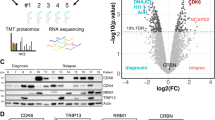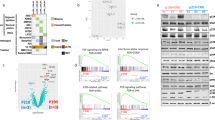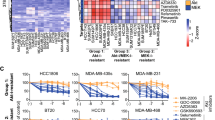Abstract
Occurrence of the BCR-ABLT315I gatekeeper mutation is among the most pressing challenges in the therapy of chronic myeloid leukemia (CML). Several BCR-ABL inhibitors have multiple targets and pleiotropic effects that could be exploited for their synergistic potential. Testing combinations of such kinase inhibitors identified a strong synergy between danusertib and bosutinib that exclusively affected CML cells harboring BCR-ABLT315I. To elucidate the underlying mechanisms, we applied a systems-level approach comprising phosphoproteomics, transcriptomics and chemical proteomics. Data integration revealed that both compounds targeted Mapk pathways downstream of BCR-ABL, resulting in impaired activity of c-Myc. Using pharmacological validation, we assessed that the relative contributions of danusertib and bosutinib could be mimicked individually by Mapk inhibitors and collectively by downregulation of c-Myc through Brd4 inhibition. Thus, integration of genome- and proteome-wide technologies enabled the elucidation of the mechanism by which a new drug synergy targets the dependency of BCR-ABLT315I CML cells on c-Myc through nonobvious off targets.
This is a preview of subscription content, access via your institution
Access options
Subscribe to this journal
Receive 12 print issues and online access
$259.00 per year
only $21.58 per issue
Buy this article
- Purchase on Springer Link
- Instant access to full article PDF
Prices may be subject to local taxes which are calculated during checkout





Similar content being viewed by others
References
Kitano, H. Cancer as a robust system: implications for anticancer therapy. Nat. Rev. Cancer 4, 227–235 (2004).
Lehár, J. et al. Synergistic drug combinations tend to improve therapeutically relevant selectivity. Nat. Biotechnol. 27, 659–666 (2009).
Lamb, J. et al. The Connectivity Map: using gene-expression signatures to connect small molecules, genes, and disease. Science 313, 1929–1935 (2006).
Rix, U. & Superti-Furga, G. Target profiling of small molecules by chemical proteomics. Nat. Chem. Biol. 5, 616–624 (2009).
Pan, C., Olsen, J.V., Daub, H. & Mann, M. Global effects of kinase inhibitors on signaling networks revealed by quantitative phosphoproteomics. Mol. Cell. Proteomics 8, 2796–2808 (2009).
Hopkins, A.L. Network pharmacology: the next paradigm in drug discovery. Nat. Chem. Biol. 4, 682–690 (2008).
Knight, Z.A., Lin, H. & Shokat, K.M. Targeting the cancer kinome through polypharmacology. Nat. Rev. Cancer 10, 130–137 (2010).
Quintás-Cardama, A. & Cortes, J. Molecular biology of BCR-ABL1–positive chronic myeloid leukemia. Blood 113, 1619–1630 (2009).
Druker, B.J. Imatinib as a paradigm of targeted therapies. Adv. Cancer Res. 91, 1–30 (2004).
Gorre, M.E. et al. Clinical resistance to STI-571 cancer therapy caused by BCR-ABL gene mutation or amplification. Science 293, 876–880 (2001).
Donato, N.J. et al. Imatinib mesylate resistance through BCR-ABL independence in chronic myelogenous leukemia. Cancer Res. 64, 672–677 (2004); erratum 64, 2306 (2004).
Mahon, F.X. et al. Selection and characterization of BCR-ABL positive cell lines with differential sensitivity to the tyrosine kinase inhibitor STI571: diverse mechanisms of resistance. Blood 96, 1070–1079 (2000).
Zhang, J., Yang, P.L. & Gray, N.S. Targeting cancer with small molecule kinase inhibitors. Nat. Rev. Cancer 9, 28–39 (2009).
Bixby, D. & Talpaz, M. Seeking the causes and solutions to imatinib-resistance in chronic myeloid leukemia. Leukemia 25, 7–22 (2011).
O′Hare, T. et al. AP24534, a pan–BCR-ABL inhibitor for chronic myeloid leukemia, potently inhibits the T315I mutant and overcomes mutation-based resistance. Cancer Cell 16, 401–412 (2009).
Eide, C.A. et al. The ABL switch control inhibitor DCC-2036 is active against the chronic myeloid leukemia mutant BCR-ABLT315I and exhibits a narrow resistance profile. Cancer Res. 71, 3189–3195 (2011).
Grebien, F. et al. Targeting the SH2-kinase interface in Bcr-Abl inhibits leukemogenesis. Cell 147, 306–319 (2011).
Packer, L.M. et al. Nilotinib and MEK inhibitors induce synthetic lethality through paradoxical activation of RAF in drug-resistant chronic myeloid leukemia. Cancer Cell 20, 715–727 (2011).
Bliss, C.I. The toxicity of poisons applied jointly. Ann. Appl. Biol. 26, 585–615 (1939).
Borisy, A.A. et al. Systematic discovery of multicomponent therapeutics. Proc. Natl. Acad. Sci. USA 100, 7977–7982 (2003).
Breitwieser, F.P. et al. General statistical modeling of data from protein relative expression isobaric tags. J. Proteome Res. 10, 2758–2766 (2011).
Ross, P.L. et al. Multiplexed protein quantitation in Saccharomyces cerevisiae using amine-reactive isobaric tagging reagents. Mol. Cell. Proteomics 3, 1154–1169 (2004).
Dennis, G. Jr. et al. DAVID: Database for Annotation, Visualization, and Integrated Discovery. Genome Biol. 4, P3 (2003).
Chen, X. et al. Integration of external signaling pathways with the core transcriptional network in embryonic stem cells. Cell 133, 1106–1117 (2008).
Subramanian, A. et al. Gene set enrichment analysis: a knowledge-based approach for interpreting genome-wide expression profiles. Proc. Natl. Acad. Sci. USA 102, 15545–15550 (2005).
Schuhmacher, M. et al. The transcriptional program of a human B cell line in response to Myc. Nucleic Acids Res. 29, 397–406 (2001).
Dopazo, J. & Carazo, J.M. Phylogenetic reconstruction using an unsupervised growing neural network that adopts the topology of a phylogenetic tree. J. Mol. Evol. 44, 226–233 (1997).
Gupta, S., Seth, A. & Davis, R.J. Transactivation of gene expression by Myc is inhibited by mutation at the phosphorylation sites Thr-58 and Ser-62. Proc. Natl. Acad. Sci. USA 90, 3216–3220 (1993).
Seth, A., Alvarez, E., Gupta, S. & Davis, R.J. A phosphorylation site located in the NH2-terminal domain of c-Myc increases transactivation of gene expression. J. Biol. Chem. 266, 23521–23524 (1991).
Hann, S.R. Role of post-translational modifications in regulating c-Myc proteolysis, transcriptional activity and biological function. Semin. Cancer Biol. 16, 288–302 (2006).
Benassi, B. et al. c-Myc phosphorylation is required for cellular response to oxidative stress. Mol. Cell 21, 509–519 (2006).
Delmore, J.E. et al. BET bromodomain inhibition as a therapeutic strategy to target c-Myc. Cell 146, 904–917 (2011).
Filippakopoulos, P. et al. Selective inhibition of BET bromodomains. Nature 468, 1067–1073 (2010).
Hantschel, O. et al. BCR-ABL uncouples canonical JAK2-STAT5 signaling in chronic myeloid leukemia. Nat. Chem. Biol. 8, 285–293 (2012).
Griswold, I.J. et al. Kinase domain mutants of Bcr-Abl exhibit altered transformation potency, kinase activity, and substrate utilization, irrespective of sensitivity to imatinib. Mol. Cell. Biol. 26, 6082–6093 (2006).
Azam, M., Seeliger, M.A., Gray, N.S., Kuriyan, J. & Daley, G.Q. Activation of tyrosine kinases by mutation of the gatekeeper threonine. Nat. Struct. Mol. Biol. 15, 1109–1118 (2008).
Cortes, J.E. et al. Safety and efficacy of bosutinib (SKI-606) in chronic phase Philadelphia chromosome-positive chronic myeloid leukemia patients with resistance or intolerance to imatinib. Blood 118, 4567–4576 (2011).
Pelengaris, S., Khan, M. & Evan, G. c-MYC: more than just a matter of life and death. Nat. Rev. Cancer 2, 764–776 (2002).
Sawyers, C.L., Callahan, W. & Witte, O.N. Dominant negative MYC blocks transformation by ABL oncogenes. Cell 70, 901–910 (1992).
Luo, B. et al. Highly parallel identification of essential genes in cancer cells. Proc. Natl. Acad. Sci. USA 105, 20380–20385 (2008).
Albajar, M. et al. MYC in chronic myeloid leukemia: induction of aberrant DNA synthesis and association with poor response to imatinib. Mol. Cancer Res. 9, 564–576 (2011).
Adhikary, S. & Eilers, M. Transcriptional regulation and transformation by Myc proteins. Nat. Rev. Mol. Cell Biol. 6, 635–645 (2005).
Meyer, N. & Penn, L.Z. Reflecting on 25 years with MYC. Nat. Rev. Cancer 8, 976–990 (2008).
Palsson, B. & Zengler, K. The challenges of integrating multi-omic data sets. Nat. Chem. Biol. 6, 787–789 (2010).
Rix, U. et al. A comprehensive target selectivity survey of the BCR-ABL kinase inhibitor INNO-406 by kinase profiling and chemical proteomics in chronic myeloid leukemia cells. Leukemia 24, 44–50 (2010).
Acknowledgements
We thank J. Bradner (Dana Faber Cancer Institute–Harvard Medical School) for providing JQ1S and JQ1R and R. Giambruno, C. Tan, J. Bigenzahn and O. Hantschel for skillful advice and help. We also thank J. Lehar for inspiring discussions and S. Nijman and O. Hantschel for carefully reading this manuscript. We thank Cell Signaling Technology for allowing reproduction of the kinome map. We acknowledge L. Brecker for measuring NMR spectra. The present work was, in part, financed by the 'GEN-AU' initiative of the Austrian Federal Ministry for Science and Research (PLACEBO GZ BMWF-70.081/0018-II/1a/2008) as well as the Austrian Science Fund (P 24321-B21).
Author information
Authors and Affiliations
Contributions
G.E.W. designed and performed the experiments, analyzed and interpreted the data, performed statistical analyses, made the figures and wrote the manuscript. U.R. designed and performed the experiments, analyzed and interpreted the data, performed statistical analyses, made the figures and wrote the manuscript. S.M.C. performed phosphoproteomics studies and analyzed and interpreted the resulting data. K.V.G. performed experiments in primary human samples and analyzed and interpreted the data. F.G. performed fluorescence-activated cell sorting analysis and helped perform colony formation assays. M.G. carried out immunoblot experiments. A.C.M. performed pre-phosphoproteomic screening studies and analyzed quantitative drug pulldowns by mass spectrometry. F.P.B. analyzed quantitative proteomics data and performed bioinformatic experiments. M.B. performed microarray experiments. J.C. analyzed chemical proteomics experimental data and performed bioinformatic analysis. P.V. planned experiments, contributed patient samples and gave advice on the research. K.L.B. planned experiments and analyzed chemical proteomics experiments. F.M.W. planned experiments and analyzed phosphoproteomics data. G.S.-F. conceived of the experimental strategy with G.E.W. and U.R., had overall responsibility for the research and wrote and edited the manuscript.
Corresponding author
Ethics declarations
Competing interests
The authors declare no competing financial interests.
Supplementary information
Supplementary Text and Figures
Supplementary Methods and Supplementary Results (PDF 25200 kb)
Supplementary Data Set 1
Supplementary Dataset 1.xlsx (XLS 201 kb)
Supplementary Data Set 2
Supplementary Dataset 2.xlsx (XLS 142 kb)
Supplementary Data Set 3
Supplementary Dataset 3.xlsx (XLS 43 kb)
Rights and permissions
About this article
Cite this article
Winter, G., Rix, U., Carlson, S. et al. Systems-pharmacology dissection of a drug synergy in imatinib-resistant CML. Nat Chem Biol 8, 905–912 (2012). https://doi.org/10.1038/nchembio.1085
Received:
Accepted:
Published:
Issue Date:
DOI: https://doi.org/10.1038/nchembio.1085
This article is cited by
-
KOPI: Kinase inhibitOr Proteome Impact analysis
Scientific Reports (2022)
-
DeepIDC: A Prediction Framework of Injectable Drug Combination Based on Heterogeneous Information and Deep Learning
Clinical Pharmacokinetics (2022)
-
Rational discovery of molecular glue degraders via scalable chemical profiling
Nature Chemical Biology (2020)
-
Global survey of the immunomodulatory potential of common drugs
Nature Chemical Biology (2017)
-
MTI-101 treatment inducing activation of Stim1 and TRPC1 expression is a determinant of response in multiple myeloma
Scientific Reports (2017)



